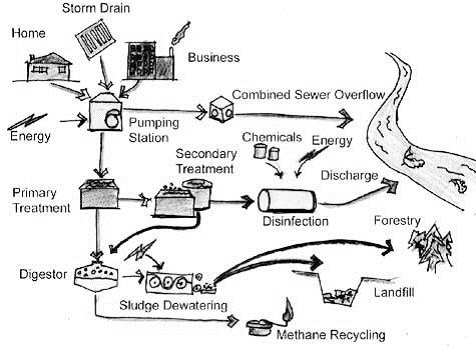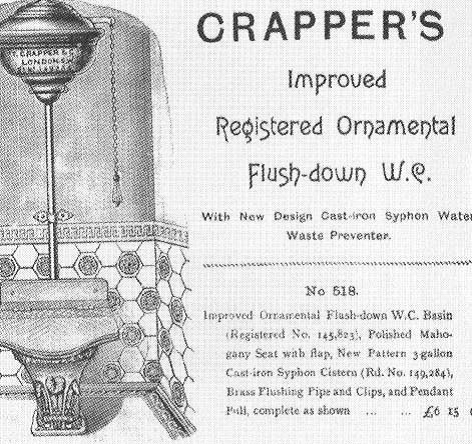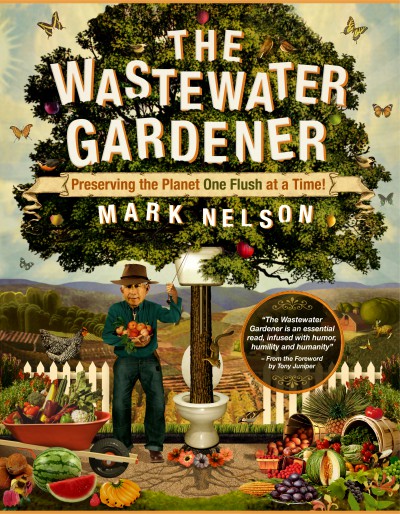The following is excerpted from The Wastewater Gardener: Preserving the Planet One Flush at a Time, published by Synergetic Press.
“He can’t tell the shit from the shinola.” —American folk saying for incorrigible stupidity
There’s a four letter word that still awaits liberation: it is considered to be far nastier than sex, which is used to sell the global economy’s products, to entertain and enthrall people and to power our gossip, soap operas and talk radio. But this word is never brought up in polite society, certainly never at dinner table conversations, and is equally repugnant to Left and Right. Yet it’s everywhere, certainly everywhere there are people.
We employ endless euphemisms to avoid having even to say it or to think about its use and abuse: from baby talk “caca” and George W. Bush’s “deep doo-doo,” to hands up in school to request priority permission to take care of “number two.” It’s the New-Agey organic “humanure,” the dryly academic “excrement” or “human solid waste product.”
It’s also the somewhat archaic “night soil” and in the jargon of sewage professionals and recyclers, it’s “black water,” as opposed to “graywater” (all the other “wastewater” from the laundry, kitchens, sinks and showers). People go to great lengths to avoid seeing, smelling, touching, thinking about or dealing with it.
Of course, I’m talking about “shit,” a word for which many languages have negative connotations, as in “merde” (French) or “Scheiss” (German).
Sigmund Freud defined the progress of sexual development in human psychology from oral, to anal, to genital stages. Contrast the very young child’s sensuous pleasure in the process of defecation with the widespread anal-retentive behavior seen in many adults for whom the very mention of the word “shit” produces consternation.
But what if I told you that in Medieval Europe, this same substance was valued as a medicine and even used as a cosmetic for preserving the youthful appearance of a woman’s face?1 As we will later discuss in more detail, throughout the world the use of human as well as animal manure fertilizer endowed it with great value. It was regarded as a resource, not as waste to be disposed, at least in Asia until the beginning of the twentieth century. In Japan and China, “shit” is still never used as a negative word. During the Korean War US soldiers were astonished to see Korean farmers entice travelers to use their outhouse toilets so they could collect their excrement.
Ponder a popular exclamation to express wonder. The ancient Manicheans viewed the entire cosmos as a turd of God, yea verily, it is the Holy Shit!
Facts and figures
An adult human produces about one half to one pound of waste per day. With more than seven billion people on the planet, that comes to at least three and a half billion pounds or 1.75 million tons per day; over 600 million tons, per year!
When there were only a few million humans scattered in small groups around the world, the danger of pollution from human waste was fairly small. Most cultures have an instinctive aversion to fouling the nest. People used to go out to the woods or meadows to defecate, depositing their humanure on the soil where microbes can easily decompose it and make its nutrients available for plants. Human feces can cause a multitude of diseases, including major killers endemic in the developing world: diarrhea, cholera and typhoid. Contamination and the spread of disease are found even in cultures renowned for their ecological sustainability. In the rice-paddy networks on the island of Bali and elsewhere in Southeast Asia, infant mortality rates remain high partly because drinking water is polluted by human shit.
Many cultures used to acknowledge the value of humanure as a fertilizer and developed composting practices where it was mixed with plant and vegetable waste to make topsoil. They handled the substance carefully, seeing it as a natural resource. Among the traditional cultures of China, Japan and Korea, the humanure that was produced in cities neither contaminated drinking water supplies, nor cost a city a fortune to dispose of or treat. These “farmers of forty centuries” understood the importance of returning the nutrients contained in humanure back to the farms. “Night soil” was collected by contractors who paid for the opportunity. The material was loaded into boats and sent up river to be sold to farmers who then used it for making compost or directly fertilizing their fields and crops. It was simple: a farmer grew food, shipped it to the city whose waste products were then collected and returned to the countryside. These cultures were able thus to maintain soil fertility, century after century. For the cities, the shit was a source of revenue, not a problem requiring the expense of modern sewage treatment facilities. The idea of throwing away a valuable resource and causing pollution was inconceivable.

Indoor plumbing
As human population increased and became more urbanized, traditional collection and reuse methods became more difficult to implement. In the West, an understanding of the value of human waste as fertilizer was superseded by the convenience of using chemical fertilizers. Farm animals like draft horses and oxen were being replaced by fossil fuel- driven tractors, so a huge source of animal fertilizer and compostable material was now gone. Farmers used to be generalists, raising animals and crops. Modern farmers tend to be specialists. Today’s farms are either meat factories, where animals are raised in automated facilities and the animal waste is a problem that ends up polluting rivers and groundwater, or they are crop specialists, relying on chemical fertilizers. An unintended consequence of crop specialization is runoff of chemical fertilizers into the environment. Fertilizer runoff and sewage are the leading causes of water pollution on the planet. Chemical fertilizers, though so convenient and easy to apply, are both expensive and costly to the environment. Their production and long distance transport significantly add carbon dioxide and contribute to climate change. As much as half the chemical nitrogen applied to crops and 20% of the phosphorus washes off into groundwater, rivers, lakes and ultimately into the oceans.
There are those who see indoor plumbing as the mark of a civilized society and the solution to the epidemics that periodically broke out prior to the nineteenth century. Instead of having to venture out, especially on cold nights, to an outdoor toilet or privy, you could now conveniently defecate in the comfort of your own home. And to remove the waste, just add fresh, portable water! One benefit: no unpleasant odor when workers came to remove the contents of the outhouse. So now we have a centralized system. Send the humanure to a municipal sewage treatment plant, where trained specialists detoxify the shit and make it fit for final disposal—note: disposal, not usage.
In less densely populated urban areas and in the countryside, indoor plumbing is generally attached to a septic tank and leach field disposal system. The sewage solids are separated in the septic tank, and the remaining wastewater is percolated through perforated pipes laid in trenches of gravel in the hope it will be cleaned before it reaches groundwater. Solids (sludge) that are pumped out from the septic tank are taken to the centralized sewage treatment facility. Except, of course, in poorer countries where the sewage hauler might head for the nearest jungle, mangrove swamp or deserted lot to dump the load. Dumping costs less: less fuel expenditure and no fees need be paid to the sewage plant.
Evidence of indoor plumbing and the use of water to carry away human effluent can be traced back to examples in India, Scotland, and the famous Cloaca Maxima (Greatest Sewage System) of ancient Rome. Its modern reinvention was centered in northern Europe, especially England, starting in the late fifteenth century. Indoor plumbing had vastly improved by the late nineteenth century and rapidly caught on in the great cities. Urbanites had the astonishing modern convenience of having their water piped, rather than hauled, into their homes. But don’t forget “the law of unintended consequences” and what then came about due the wonderful convenience of indoor plumbing.

While some praise indoor plumbing and the flush toilet as sterling achievements, for others it is the height of insanity to use drinking water to dispose of human waste and then wash it away into large bodies of water, spreading the potential for pollution of all Earth’s water bodies.
When per capita fresh water usage in towns and cities was low because water had to be hauled into houses, waste was deposited into pit latrines or cesspools located in backyards or at some distance from dwellings (because of the odor). The accumulated waste was then transported to nearby farms for use as fertilizer. Before the nineteenth century, a city’s open “sewers” were used to disperse rainwater and urban detritus. The development of pipes bringing water into the residential buildings of nineteenth century Europe, North America and other wealthy countries also led to a huge increase in water consumption: from 5 gallons (20 liters) to 30-50 gallons (120-200 liters), per person, per day. So, once indoor plumbing came along, the backyard privy or cesspool was now fed with shit washed out through pipes, using copious amounts of fresh water. This inevitably led to overflows, a horrible stench and thence a desperate search for a solution.
The first fix was the use of open sewers to transport sewage away from population centers. This resulted in deadly outbreaks of waterborne diseases like cholera and typhoid. The next fix was to create a network of pipes to protect the population from the pathogens in raw sewage. But where should all the sewage go? Arguments raged between those who wanted to send it to fields as fertilizer, and those who favored sending it to the closest river, lake or coastal water for disposal. It was won by the latter. The mantra was “running water purifies itself.” Not really, and not sufficiently for cities downstream which now had to use water that was seriously polluted. The next techno-fix was downstream cities filtering and then disinfecting the water with chlorine before using it. Now that previously unpolluted aquatic ecosystems were polluted with human waste and excessive nutrients, the need arose for yet another techno-fix: “treating” the wastewater. Thus evolved the modern sewage treatment plant, designed to clean and disinfect wastewater before discharging it into a river or ocean.
Problems have arisen with this approach. The pollution of waters is now virtually everywhere. The reason is simple: where do you send those millions of gallons of effluent—the liquid waste, increased in volume by the water needed to flush it away? The amount of water needed per human bowel movement can be as much as 5 gallons (20 liters) with old style toilets, down to 1 to 2 gallons (4-8 liters) with modern, water-conserving flush toilets. If 2 billion people are using a centralized sewage system and visit the loo twice a day, that’s between 2 and 10 billion gallons (8 to 40 billion liters) of sewage water per day. If it takes one or two thousand tons of water to move each ton of shit, it’s lucky that most cities are adjacent to a river, lake or an ocean.

In rural areas septic tank systems release wastewater which percolates down into the water table. Where the population is low, or where there are deep aquifers, there is little problem with this situation. Where the water table is closer to the surface or population density is high, groundwater is at risk of contamination. Few realize that even in developed, urbanized countries like the United States, over a quarter of the population send their waste to septic tank and leach drain systems, not to centralized sewage treatment plants.
This huge waste of water is unsustainable. It would be one thing if the water used to flush was of low quality. It isn’t. We use fresh, potable water. Human excrement contains 5-7% nitrogen and 3-5% phosphorus, two valuable nutrients, understood as critical for plant growth because of their relative scarcity and irreplaceability being flushed down the toilet in the name of hygiene.

I can’t resist sharing an anecdote before we leave the topic of indoor plumbing. In the mid-nineteenth century, an Englishman named Thomas Crapper was marketing his new invention: an improved indoor toilet seat with a water siphoning system to regulate the amount of water needed for flushing. Previously, a vast amount of water was wasted since the amount used was determined by the user—turn on the water until it washed all the solids away. But now you could pull a chain and a regulated amount of water would flush your waste away. Thomas was rewarded by being appointed plumber to the Royal Family. It did not occur to him that his name and invention would be immortalized in the English speaking world. American soldiers, for example, who saw the name on English plumbing fixtures, during World War One, would say: “Excuse me, but I’ve got to go to the ‘crapper.’”
The Solution to Pollution is Dilution
Why is dilution considered acceptable? Well, believe it or not, the adage of sanitary engineers of old was “the solution to pollution is dilution.” In other words, they imagined that there’s enough water in that river, lake, or ocean which will dilute the sewage we put into it, to the point where it’s not a problem any longer. Consider the corollary in trying to solve air pollution problems. It would be to build smokestacks ever taller so that the pollutants in the air can’t be smelled or deposited locally. Instead they just get dispersed in the air currents of the upper atmosphere. The entire global atmosphere is thought of as large enough to make the problem disappear.
Another consequence of indoor plumbing and centralized sewage disposal was that it was decided that the same solution should be applied to industrial waste. This was very convenient for industry, since taxpayer dollars could be used to pay for removing its waste. So, in “advanced countries” pipes carry away both the relatively innocuous humanure and other wastewater from the family home as well as the chemicals from dry cleaners, photo labs, food processing plants and factories. A dizzying variety of man-made chemicals have been thrust into our environment, including deadly pesticides as well as heavy metals. The presence of these compounds has made the disposal or reuse of sewage sludge (the solids removed at the sewage plant) much more difficult and hazardous as long-term health consequences are little understood. Application of sewage sludge on land as a fertilizer raises the danger of further contamination of soil and water, and of uptake by crops. Amazingly, this subsidy that industry enjoys and the environmental and economic costs of mixing human and industrial sewage, is rarely discussed. Separating industrial waste from domestic waste would now be very difficult since a huge infrastructure has been built in the world’s cities, based on the notion that it was okay to mix them in the first place.
The thinking behind indoor plumbing and centralized sewage treatment plants was based on the ease with which one could dispose of the nasty stuff and a recognition of the health hazards associated with waste disposal. Contact with improperly treated shit can spread disease. These diseases are at devastating and increasing levels in the poorer, developing countries of the world. The “North,” the developed world, suffers from problems caused by indoor plumbing, i.e., polluted water bodies and increasing difficulty in disposing of industrial sludge and the need for expensive sewage disposal infrastructure. The “South,” the developing world (formerly called “the Third World”) faces a different problem. The United Nations Development Program (UNDP) estimates that more than a billion people lack access to clean drinking water and three billion people lack access to adequate sanitation. In developing countries, 95% of the sewage is discharged untreated, polluting groundwater, rivers, lakes and coastal areas. Since groundwater, rivers and lakes supply drinking water, the consequences to health are dire. Over a billion people in these developing countries suffer from diseases caused by contaminated drinking water. The number of people who die each year from waterborne diseases totals three and a half million, mostly children under age five. That’s more than 9,000 people a day who die from illnesses caused by the pollution of water. Diseases caused by sewage contamination of drinking water are by far the world’s greatest killer.
Sanitary engineers of the 19th and 20th centuries can rightly point to an improvement in human hygiene due to the use of indoor plumbing and sewage systems—a vital factor in better sanitary standards, a reduction in the spread of infectious disease, a decrease in child mortality and an increase in life expectancy. But it’s now time for a paradigm shift in thinking and implementation of effective but more ecologically attuned solutions.
Human shit is not a toxic waste product and should not be treated as if it were. Throwing away vast amounts of potable water is increasingly untenable in a world facing a shortage of fresh water. Solutions to health and fresh water issues in the developing world do not have to replicate the energy-consuming, wasteful technologies that were adopted by Western countries. The costs of building and maintaining centralized sewage treatment plants are not only enormous, the world’s supply of freshwater will not permit extending these wasteful practices even to the world’s current population. Freshwater shortages and increasing water pollution are making it clear that developed countries too cannot afford to continue such practices indefinitely.
Planet Earth is two-thirds ocean. As the great inventor and thinker R. Buckminster Fuller noted, it should really be called Planet Ocean. However, 97% of our planet’s water is salty and not suitable for drinking or for irrigation. Most fresh water exists as ice, in the Polar Regions. Potable water is a precious and scarce resource.
But we are not “up the creek without a paddle.” In this book, I take you on my thirty-year odyssey around the world, looking for ways out of this shitty mess.
Notes
[1] La Porte, Dominique: History of Shit, trans. Nadia Benabid and Rodolphe el-Khoury, MIT Press, Cambridge MA, 2000, Chapter 5: Make-up, pp. 96-112.
Mark Nelson, PhD, is an ecosystem engineer and researcher, and one of the original “Biospherians.” He is Chairman, CEO, and a founding director of the Institute of Ecotechnics, a UK and US nonprofit organization consulting on several demonstration projects working in challenging biomes around the world. He is head of the Biospheric Design Division, Global Ecotechnics Corporation. Founder and director of Wastewater Gardens International, he designs and implements sewage treatment and recycling systems using constructed wetlands.













